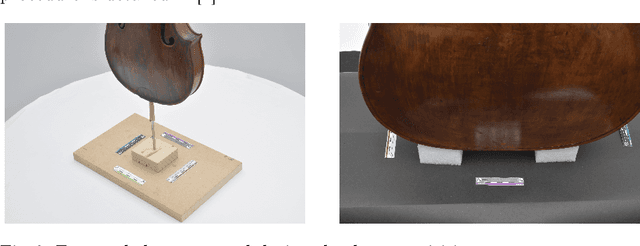Philémon Beghin
Identification of Violin Reduction via Contour Lines Classification
Jul 10, 2025Abstract:The first violins appeared in late 16th-century Italy. Over the next 200 years, they spread across Europe and luthiers of various royal courts, eager to experiment with new techniques, created a highly diverse family of instruments. Around 1750, size standards were introduced to unify violin making for orchestras and conservatories. Instruments that fell between two standards were then reduced to a smaller size by luthiers. These reductions have an impact on several characteristics of violins, in particular on the contour lines, i.e. lines of constant altitude, which look more like a U for non reduced instruments and a V for reduced ones. While such differences are observed by experts, they have not been studied quantitatively. This paper presents a method for classifying violins as reduced or non-reduced based on their contour lines. We study a corpus of 25 instruments whose 3D geometric meshes were acquired via photogrammetry. For each instrument, we extract 10-20 contour lines regularly spaced every millimetre. Each line is fitted with a parabola-like curve (with an equation of the type y = alpha*abs(x)**beta) depending on two parameters, describing how open (beta) and how vertically stretched (alpha) the curve is. We compute additional features from those parameters, using regressions and counting how many values fall under some threshold. We also deal with outliers and non equal numbers of levels, and eventually obtain a numerical profile for each instrument. We then apply classification methods to assess whether geometry alone can predict size reduction. We find that distinguishing between reduced and non reduced instruments is feasible to some degree, taking into account that a whole spectrum of more or less transformed violins exists, for which it is more difficult to quantify the reduction. We also find the opening parameter beta to be the most predictive.
A discussion about violin reduction: geometric analysis of contour lines and channel of minima
Apr 02, 2024



Abstract:Some early violins have been reduced during their history to fit imposed morphological standards, while more recent ones have been built directly to these standards. We can observe differences between reduced and unreduced instruments, particularly in their contour lines and channel of minima. In a recent preliminary work, we computed and highlighted those two features for two instruments using triangular 3D meshes acquired by photogrammetry, whose fidelity has been assessed and validated with sub-millimetre accuracy. We propose here an extension to a corpus of 38 violins, violas and cellos, and introduce improved procedures, leading to a stronger discussion of the geometric analysis. We first recall the material we are working with. We then discuss how to derive the best reference plane for the violin alignment, which is crucial for the computation of contour lines and channel of minima. Finally, we show how to compute efficiently both characteristics and we illustrate our results with a few examples.
Validation of a photogrammetric approach for the study of ancient bowed instruments
May 18, 2022



Abstract:Some ancient violins have been reduced throughout their history. We propose an objective photogrammetric approach to differentiate between a reduced and an unreduced instrument, where a three-dimensional mesh is studied geometrically by examining 2D slices. First, we validate the accuracy of the photogrammetric mesh by the way of a comparison with reference images obtained with medical imaging. Then, we show how contour lines and channels of minima can be automatically extracted from the photogrammetric meshes, allowing to successfully highlight differences between instruments.
 Add to Chrome
Add to Chrome Add to Firefox
Add to Firefox Add to Edge
Add to Edge